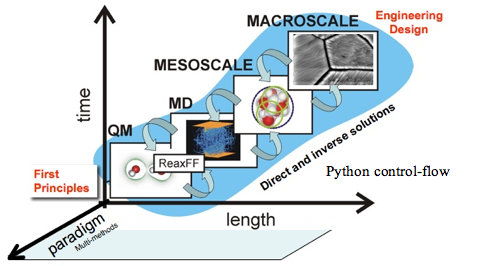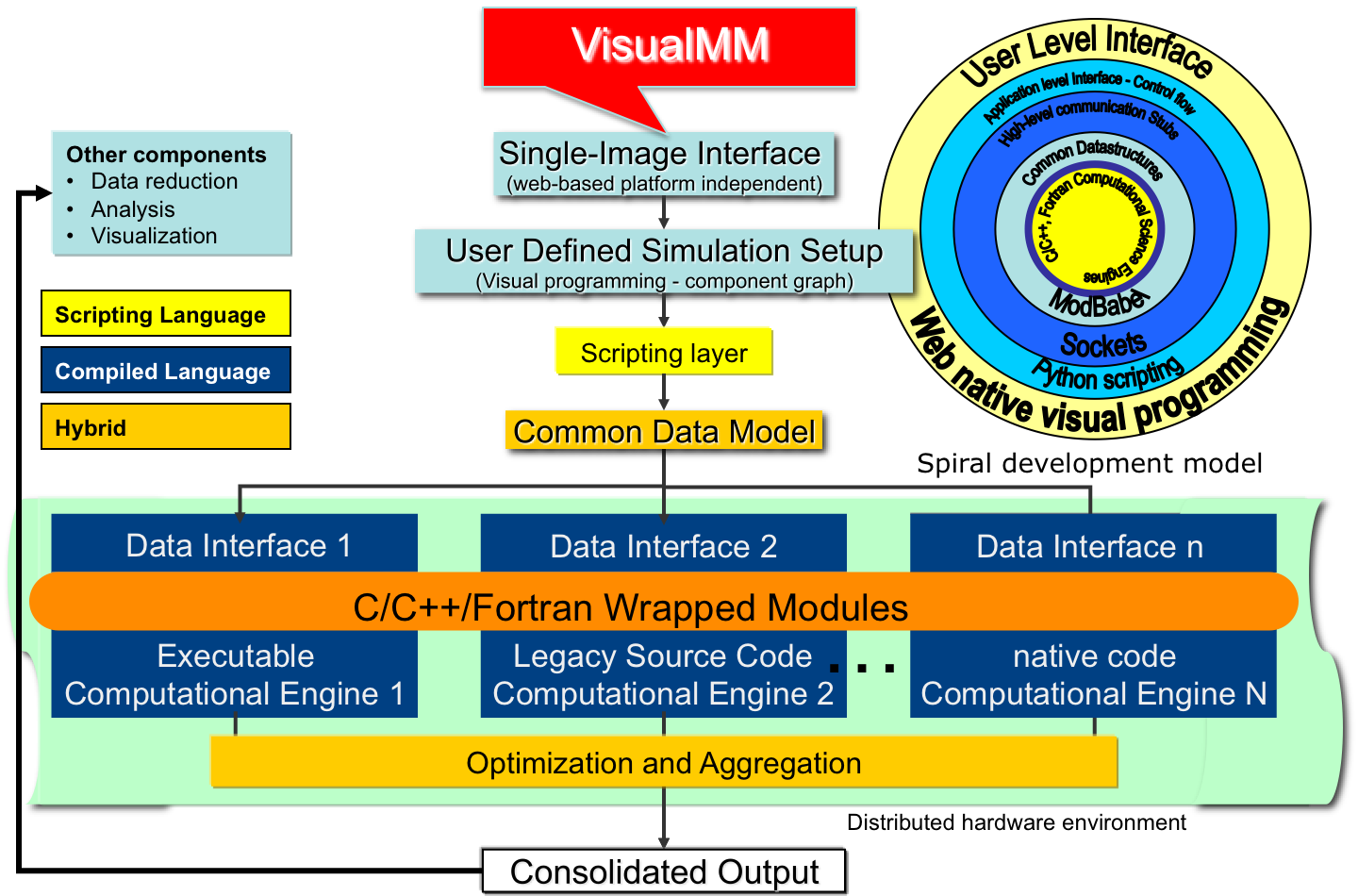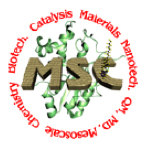|


| |
Projects

|
|
|
Funding
Agencies |
As part of the
ASCI/ASC Alliance (Center for Simulation of Dynamic Response of Materials)
DOE
Others (partial):
NSF, DARPA-PROM |
|
Start date |
1998 |
|
Expires |
Ongoing |
| |
|
|
MSC
Investigators |
 |
William A.
Goddard, III (Principal Investigator) |
 |
Andres
Jaramillo-Botero (Co-Principal Investigator, Coord.) |
 |
Yi Liu
(Co-Principal Investigator) |
 |
Adri van Duin
(Co-Principal Investigator) |
Past members:
 |
Markus Buehler
(Co-Principal Investigator, now at MIT)
|
 |
Peter Meulbroek
(Director Software Architecture and Design) |
 |
Jef Dodson
(Software Development) |
|
| Abstract |
|
 |
 CMDF is a single-image
materials and process modeling and simulation framework, integrated from
different tools and engines, intended to allow hierarchical traversal
between different length and time scales (first-principles quantum-mechanic
<-> continuum mechanics), and between disparate paradigms (i.e. alternate
methods) per scale. Its goal is to enable de novo design of new or
optimized materials with improved performance and to enable first-principles
predictive science in chemistry, physics and biology. CMDF is a single-image
materials and process modeling and simulation framework, integrated from
different tools and engines, intended to allow hierarchical traversal
between different length and time scales (first-principles quantum-mechanic
<-> continuum mechanics), and between disparate paradigms (i.e. alternate
methods) per scale. Its goal is to enable de novo design of new or
optimized materials with improved performance and to enable first-principles
predictive science in chemistry, physics and biology.
CMDF uses the Python programming language
to control the computational flow between disparate processing cores written
in compiled languages (C/C++/Fortran) that carry out physicochemical
calculations for multiscale/multiparadigm under a unified data model.
Recently, CMDF's software architecture was re-modeled and re-specified using
the UML (Unified Modeling Language) in order to enhance its overall
flexibility and run-time performance, as well as to guarantee a
highly-decoupled, component based, development/maintenance process - we use
a spiral software methodology with short-term incremental cascade-type
intervals (that include unit and system testing). |
| |
|
|
| |
| Related Publications |
 | Jaramillo-Botero et al "Multiscale-Multiparadigm
Modeling and Simulation of Nanometer Scale Systems and Processes for
Nanomedical Applications", in Book, Nanomedicine: A Systems Engineering
Approach, Pan Stanford Publishing (World Scientific), Nov. 2008 |
 | Multiparadigm modeling of dynamical crack propagation
in silicon using a reactive force field, Buehler, et al,Phys. Rev. Lett.,
96 (9): Art. No. 095505 (2006) |
|

|
|
|
Start date |
Design and
prototyping for proof-of-concept started in 2007, as a front-end for CMDF
|
| Observations |
Funding required in order to
develop and deploy a full-blown integrated service for a Materials Science
digital library, using CMDF engines integrated under a web-native visual
framework. |
|
Investigators
and students |
Others involved
(initial Python-based prototype for multi-component modeling):
 |
Victor Rivera
(Graduate student in Computer Engineering, Pontificia Universidad Javeriana)
|
 |
Jorge Victoria
(Graduate student in Computer Engineering, Pontificia Universidad
Javeriana) |
|
| Abstract |
|
 |
 |
 |
The
complexities of physical phenomena, and the growing number of new modeling
paradigms for exploring various time and length-scales, limit the use of
current modeling programs to experts. Specialized courses, with steep
learning curves, enable students and seasoned researchers to make use of
these tools. Yet, the complexity is necessary to realistically model many
processes or materials with sufficient completeness and resolution.
Enabling computations in a user-friendly and computer-language agnostic
fashion to expand the user base remains a great challenge. This is
particularly true for both performing scientific research and for training
or teaching complex problems in the natural sciences. We propose a new
scalable web-based framework for modeling multi-scale, multi-paradigm
phenomena, aimed at enabling a collection of services using the algorithms
and theory serviced by the expert. The framework is based on a distributed
hybrid data-flow visual modeling and execution engine, which implicitly
handles multithreading and concurrent processes over web-services.
This framework provides
a "single-image" interface that allows a visual specification of complex
multiscale, multiparadigm simulations while hiding (with progressive
disclosure) most of the programming specifics from the user (see top left
figure). This is ideal
for on-line learning and peer-to-peer collaborations since any user would
have access to publicly exposed services, distributed over the Internet,
registered and enhanced through digital libraries to aggregate
community-contributed models and engines for handling complex
physical/chemical problems (see top rigth figure).
We have
developed a preliminary proof-of-concept prototype
code-named VisualMM for handling the multiple paradigm components of this
framework for molecular level simulations in Material Science; it consists
of a Python-based visual programming layer with an underlying web-services layer in SOAP capable of controlling
and coupling the computation flow of disparate physics paradigms running
over a distributed environment. The components of a network model
(graph) can be
anything from pure Python code to wrapped compiled (fast) codes from our CMDF framework (refer to the figure to the left).
Ongoing tests and validations are being performed with the prototype using
quantum mechanics, molecular mechanics and dynamics, and coarse-grain force
field-based mesodynamics engines, yet
we expect to develop a full-blown framework capable of handling systematic
paradigm and scale couplings, accessible from a public digital
library such as NSF's NSDL.
|
| |
|
|
| |
| Related Publications |
 | Coming Soon... |
|
|


![]()